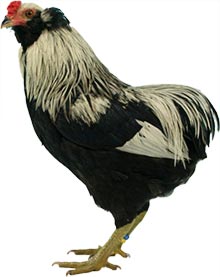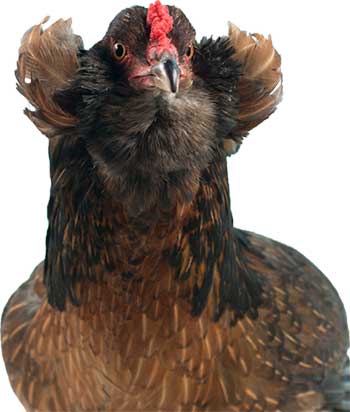
Uses: Coloured Egg Layer / Exhibition.
Eggs: 170-180 Blue / Green.
Origin: Chile / South America.
Weight: Cock: 2.7Kg, Hen: 2.25Kg.
Bantam: Cock: 910g, Hen: 790g.
Colours: Black, Black-Red, Blue, Blue-Red, Creole, Cuckoo, Golden Duckwing, Lavender, Pile, Silver Duckwing, Spangled, White (Standardised).
Useful to Know: What we call Rumpless Araucanas are called ‘Araucanas’ in America. To confuse matters further, what the British call Araucanas are called ‘Americaunas’ in the Americas. When crossed with any other breed, the offspring will lay a green/blue egg.
Photo: Duckwing Tufted Rumpless Araucana owned by Colin Booth.
 Rumpless Araucana chickens are called ‘Araucanas’ in the American Standard of Perfection, and Araucanas are called ‘Americaunas’. Since the 1920s, there has been much discussion between American and European poultry experts on what an Araucana should look like!
Rumpless Araucana chickens are called ‘Araucanas’ in the American Standard of Perfection, and Araucanas are called ‘Americaunas’. Since the 1920s, there has been much discussion between American and European poultry experts on what an Araucana should look like!
The different names in America started with the two governing bodies: The American Poultry Association (APA) and the American Bantam Association (ABA), who now work in harmony. The ABA standardised the Araucana in 1965 and allowed rumpless and tailed types in bantams with and without ear tufts. The APA admitted rumpless types with ear tufts in 1976. The tailed types were then standardised as Americaunas in the early 1980s when they harmonised the standards.
The Rumpless Araucana is a truly unique breed. Firstly, it has tufts of feathers coming out from near their ears; secondly, they lay blue to green coloured eggs (other blue/green egg layers have been created from crosses with the Araucana / Rumpless Araucana) and thirdly, they are rumpless: they do not have a tail.
Originating in South America (most texts suggest Chille, but there are very early records of these chickens in many countries of South America), the Rumpless Araucana.
The Araucana breed page covers the history of the Araucana, so it is not repeated here.
Breeding Hints
If birds with good ear tufts on both sides are bred, few chicks will hatch due to the lethal gene combination. Breed birds without ear tufts or birds with small or only one ear tufts with birds with good ear tufts to get good hatch rates.
Rumpless Araucanas are required by the British Poultry Standard to have beards. In other countries, beards are also permitted, however in North America, they will be disqualified for having them. The original birds also had single combs which are now a disqualification at shows so must be avoided.
Photos
Books
The following books are available. Links take you to the Amazon or other sellers’ pages for the books.
- Popular Poultry Breeds – D. Scrivener – P.13
- Storey’s Illustrated Guide to Poultry Breeds – C. Ekarius – P. 42
- British Poultry Standards – P.45
- American Standard of Perfection (Araucana) – P.198








